How to raise Tibetan Mastiff? Tibetan Mastiff Puppy Raising Techniques

The baby Tibetan Mastiff from birth to weaning is called a Tibetan Mastiff. Correct feeding and management at this stage is extremely important. It is a critical period for whether the baby Mastiff is strong and improves the survival rate of the baby Mastiff.
1. Pay attention to preventing cold and heat: Newborn Mastiffs have poor ability to regulate body temperature. Therefore, the ambient temperature has a great influence on the life activities of young mastiffs, so special attention should be paid to the indoor ambient temperature. The mastiff house should use a semi-circular iron frame net made of thick iron bars. In winter, cover the iron frame with plastic film to prevent cold wind, and seal the front and rear windows with plastic film; in summer, remove the plastic film and use the iron frame to frame grapes, gourds and other climbing plants to shade the baby mastiff. The suitable ambient temperature for mastiffs of different ages is: 0-7 days old: 28-32°C, 8-21 days old: 27°C, and 23°C after 28 days old. Pay attention to keeping the room dry and preventing drafts.
2. Strengthen lactation: Nutritional lactation of the mother mastiff. The milk production of the mother mastiff gradually decreases after 20 days, while the milk demand of the baby mastiff is increasing day by day. Therefore, timely supplementary feeding should be provided to the female mastiff with fresh, high-quality, easy-to-digest and absorb animal and plant feed to ensure that the female mastiff has sufficient milk.
3. Improve the nutritional value of baby mastiffs: The baby mastiffs develop rapidly one month after birth and have a strong appetite. Breast milk can no longer meet their needs. They should be fed supplementary feed and some palatable liquid foods with high nutritional value and easy to digest and absorb. . For example, add milk powder, broth, cooked egg yolk, gruel, etc. to fresh milk, plus some cod liver oil, multivitamins, bone meal, etc. Otherwise, the growth and development of the baby mastiff will be affected due to malnutrition and thin body.
4. Feed young mastiffs in an appropriate amount: The gastrointestinal volume of young mastiffs is small, so they should be fed less frequently and 5-6 times a day. As the age increases, the dietary concentration and daily feeding amount should gradually increase to adapt to Improvement of daily weight gain of young mastiffs.
5. Ensure clean drinking water: Pay attention to water quality, water temperature, water volume, and time when supplying drinking water. Young mastiffs must be supplied with clean water in a timely manner and must not contain harmful substances, pathogenic microorganisms, etc. The water tank must be cleaned once a day. The amount of water you drink varies in different seasons. The amount of water you drink is the largest in summer and cannot be interrupted. The water temperature should be appropriate. Drink cool water in summer and warm water in winter, late autumn and early spring. The time to drink water should be after eating.
6. Do a good job in disease prevention and control: Before the female mastiff gives birth, the litter nest should be thoroughly disinfected. You can use caustic soda (made into a 2%-3% hot water solution), 3% Lysol and 5% formalin to alternately disinfect the delivery room, delivery box and the activity area of the baby mastiff. Regularly disinfect the eating utensils with 2% potassium permanganate. After the baby mastiff is born, take one tablet of levamisole for every 2.5 kilograms of body weight. It is dewormed twice at 30 days. The effect is very good. Regular vaccinations are done at the age of 2 months.
- What causes a dog’s runny nose?
- Why do dogs keep losing hair?
- How to prevent kennel cough in golden retrievers in winter?
- How old does a dog start to lose teeth? Things to note when dogs start losing teeth.
- How long does it take for a female dog to recover from neutering?
- How to care for young Tibetan Mastiffs?
- How to control your dog's weight after neutering surgery?
- How to train a dog to poop
- What foods should Huskies not eat?
- How to supplement calcium for Corgi puppies



